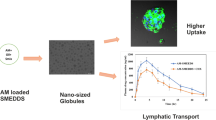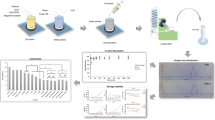Abstract
Chlormadinone acetate (CMA) is a derivative of the naturally secreted hormone progesterone and exhibits reliable contraceptive and non-contraceptive benefits. Although the marketed product of CMA as oral tablets under the trade name Belara® has been highly successful, there is still room for further improvements in oral bioavailability and a reduction in the clinical dose to decrease related adverse effects. In the current study, a CMA-based self-microemulsifying drug delivery system (SMEDDS) was developed using 32% ethyl oleate as an oil phase, 40% Tween-80 as a surfactant, and 12% Transcutol P combined with 16% PEG400 as a cosurfactant, resulting in spherical droplets with a z-average particle size of 38.92 nm and an average zeta potential of − 3.18 mv. The in vitro release rate of CMA from CMA-SMEDDS in different media (distilled water, HCl solution at pH 1.2, phosphate buffers at pH 4.5 and pH 6.8) was significantly faster than that from Belara® in the first 15 min. A pharmacokinetic study in rats showed that the Cmax and AUC of CMA-SMEDDS were significantly higher (P < 0.01) than those of Belara®, with a 1.98-fold increase in oral bioavailability. In comparison with Belara®, the developed CMA-SMEDDS showed promising release profiles both in vitro and in vivo, which could potentially be useful in enhancing oral bioavailability and reducing the clinical dose of CMA.







Similar content being viewed by others
References
Druckmann R. Profile of the progesterone derivative chlormadinone acetate—pharmocodynamic properties and therapeutic applications. Contraception. 2009;79(4):272–81.
Hadji P, Biskup J, Boekhoff J, Ziller M, Bonn M, Rovati L. Evaluation of efficacy, safety and effects on symptoms of androgenization of a generic oral contraceptive containing chlormadinone acetate 2 mg/ethinylestradiol 0.03 mg. Contraception. 2012;86(4):359–65.
Plewig G, Cunliffe WJ, Binder N, Höschen K. Efficacy of an oral contraceptive containing EE 0.03 mg and CMA 2 mg (Belara) in moderate acne resolution: a randomized, double-blind, placebo-controlled phase III trial. Contraception. 2009;80(1):25–33.
Kerscher M, Reuther T, Bayrhammer J, Schramm G. Effects of an oral contraceptive containing chlormadinone and ethinylestradiol on acne-prone skin of women of different age groups: an open-label, single-centre, phase IV study. Clin Drug Investig. 2008;28(11):703–11.
Worret I, Arp W, Zahradnik HP, Andreas JO, Binder N. Acne resolution rates: results of a single-blind, randomized, controlled, parallel phase III trial with EE/CMA (Belara) and EE/LNG (Microgynon). Dermatology. 2001;203(1):38–44.
Schramm GAK, Schrah G. The efficacy and safety of an oral contraceptive containing chlormadinone acetate: results of a pooled analysis of noninterventional trials in adult and adolescent women ☆. Contraception. 2011;84(4):390–401.
Gómez VM, Navarra AR, Lamarca M, Baquedano L, Romero RS, Vilarcheca E, et al. Ethinylestradiol/chlormadinone acetate for use in dermatological disorders. Am J Clin Dermatol. 2011;12(1):13–9.
Kanimoto Y, Okada K. Antiandrogen therapy of benign prostatic hyperplasia—review of the agents evaluation of the clinical results. Hinyokika Kiyo. 1991;37(11):1423.
Ishizuka O, Nishizawa O, Hirao Y, Ohshima S. Evidence-based meta-analysis of pharmacotherapy for benign prostatic hypertrophy. Int J Urol. 2002;9(11):607–12.
Mydlo JH, Godec CJ. Prostate cancer: science and clinical practice. 2nd ed. Cambridge: Academic Press; 2015.
Brucker C, Hedon B, The HS, Höschen K, Binder N, Christoph A. Long-term efficacy and safety of a monophasic combined oral contraceptive containing 0.02 mg ethinylestradiol and 2 mg chlormadinone acetate administered in a 24/4-day regimen. Contraception. 2010;81(6):501–9.
Callender SP, Mathews JA, Kobernyk K, Wettig SD. Microemulsion utility in pharmaceuticals: implications for multi-drug delivery. Int J Pharm. 2017;526(1–2):425–42.
Xu Y, Wang Q, Feng Y, Firempong CK, Zhu Y, Omari-Siaw E, et al. Enhanced oral bioavailability of [6]-Gingerol-SMEDDS: preparation, in vitro and in vivo evaluation. J Funct Foods. 2016;27:703–10.
Yang FF, Zhou J, Hu X, Cong ZQ, Liu CY, Pan RL, et al. Improving oral bioavailability of resveratrol by a UDP-glucuronosyltransferase inhibitory excipient-based self-microemulsion. Eur J Pharm Sci. 2017;114:303–9.
Yeom DW, Son HY, Kim JH, Kim SR, Lee SG, Song SH, et al. Development of a solidified self-microemulsifying drug delivery system (S-SMEDDS) for atorvastatin calcium with improved dissolution and bioavailability. Int J Pharm. 2016;506(1–2):302–11.
Dong WY, Bo RC, Son HY, Jin HK, Chae JS, Song SH, et al. Enhanced oral bioavailability of valsartan using a polymer-based supersaturable self-microemulsifying drug delivery system. Int J Nanomedicine. 2017;12:3533–45.
Huo T, Tao C, Zhang M, Liu Q, Lin B, Liu Z, et al. Preparation and comparison of tacrolimus-loaded solid dispersion and self-microemulsifying drug delivery system by in vitro/in vivo evaluation. Eur J Pharm Sci. 2017;114:74.
Patel AR, Vavia PR. Preparation and in vivo evaluation of SMEDDS (self-microemulsifying drug delivery system) containing fenofibrate. AAPS J. 2007;9(3):E344–52.
Kyatanwar AU, Jadhav KR, Kadam VJ. Self micro-emulsifying drug delivery system (SMEDDS) : review. J Pharm Res. 2015;3(1):75–83.
Yeom DW, Song YS, Kim SR, Lee SG, Kang MH, Lee S, et al. Development and optimization of a self-microemulsifying drug delivery system for atorvastatin calcium by using D-optimal mixture design. Int J Nanomedicine. 2017;10(6):3865–77.
Mcclements DJ. Nanoscale nutrient delivery systems for food applications: improving bioactive dispersibility, stability, and bioavailability. J Food Sci. 2015;80(7):N1602–11.
Brandlin C.Your body,your genes,your digestion,and your metabolism. 1st ed. United States: Xlibris; 2013.
Raijmakers MTM, Jansen PLM, Steegers EAP, Peters WHM. Association of human liver bilirubin UDP-glucuronyltransferase activity with a polymorphism in the promoter region of the UGT1A1 gene. J Hepatol. 2000;33(3):348–51.
Patel D, Sawant KK. Self micro-emulsifying drug delivery system: formulation development and biopharmaceutical evaluation of lipophilic drugs. Curr Drug Deliv. 2009;6(4):419–24.
Sivacharan K, Rajesh KG. Pharmacokinetic aspects and in vitro-in vivo correlation potential for lipid-based formulations. Acta Pharm Sin B. 2014;4(5):333–49.
Chatterjee B, Almurisi SH, Dukhan AAM, Mandal UK, Sengupta P. Controversies with self-emulsifying drug delivery system from pharmacokinetic point of view. Drug Delivery. 2016;23(9):3639–52.
Acknowledgments
The project was supported by grants from the Scientific Research Project of Shanghai Municipal Health and Family Planning Commission (20154Y0032).
Author information
Authors and Affiliations
Corresponding author
Ethics declarations
All experiments were performed according to the guidelines for the care and use of animals established by the Shanghai Institute of Planned Parenthood Research, which have already been approved by the ethics committee of the Shanghai Institute of Planned Parenthood Research (No. 2015-14).
Conflict of Interest
The authors declare that they have no conflict of interest.
Additional information
Enhanced Oral Bioavailability of CMA by a SMEDDS
Rights and permissions
About this article
Cite this article
Zeng, J., Chen, J., Chen, L. et al. Enhanced Oral Bioavailability of Chlormadinone Acetate through a Self-Microemulsifying Drug Delivery System for a Potential Dose Reduction. AAPS PharmSciTech 19, 3850–3858 (2018). https://doi.org/10.1208/s12249-018-1193-y
Received:
Accepted:
Published:
Issue Date:
DOI: https://doi.org/10.1208/s12249-018-1193-y




